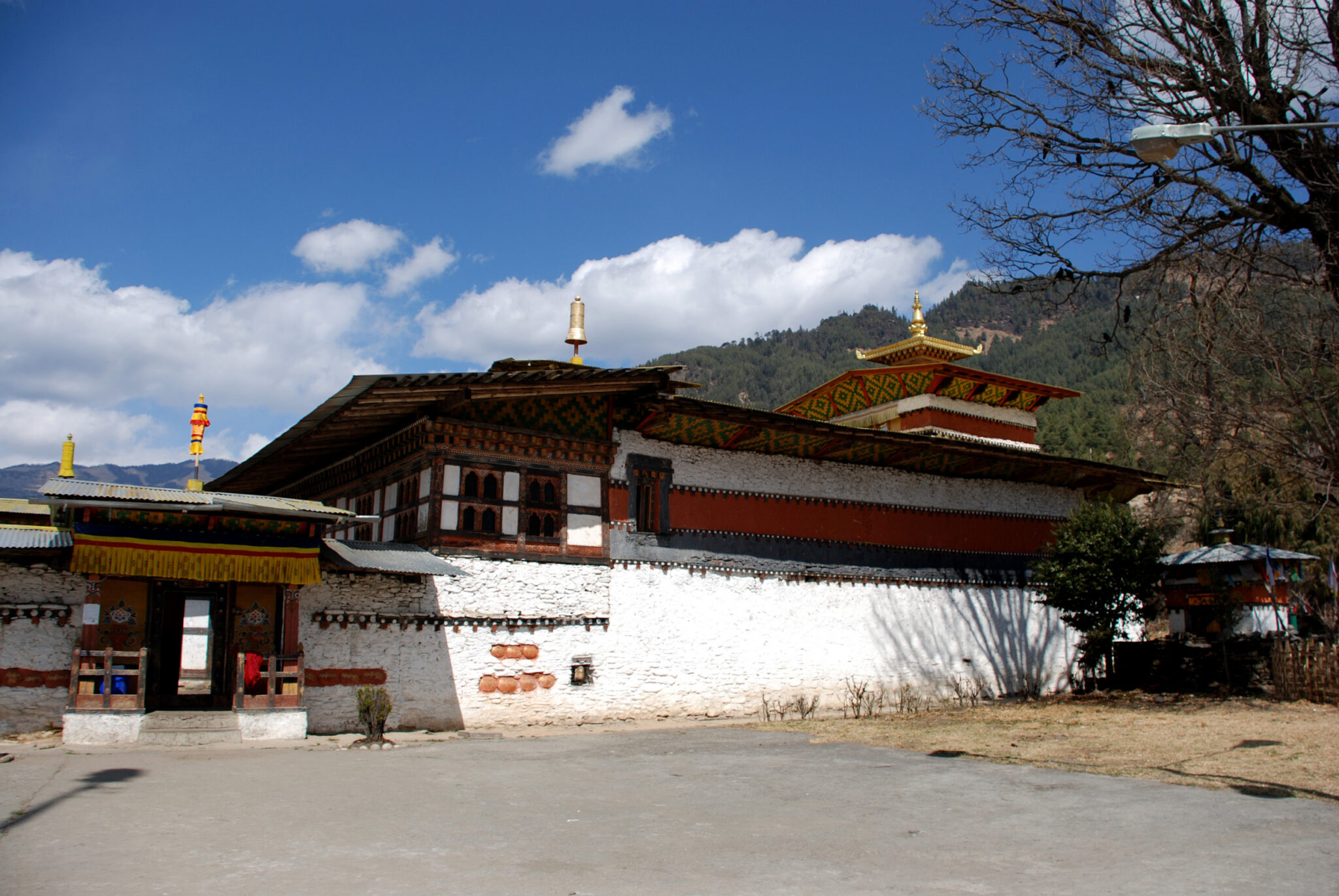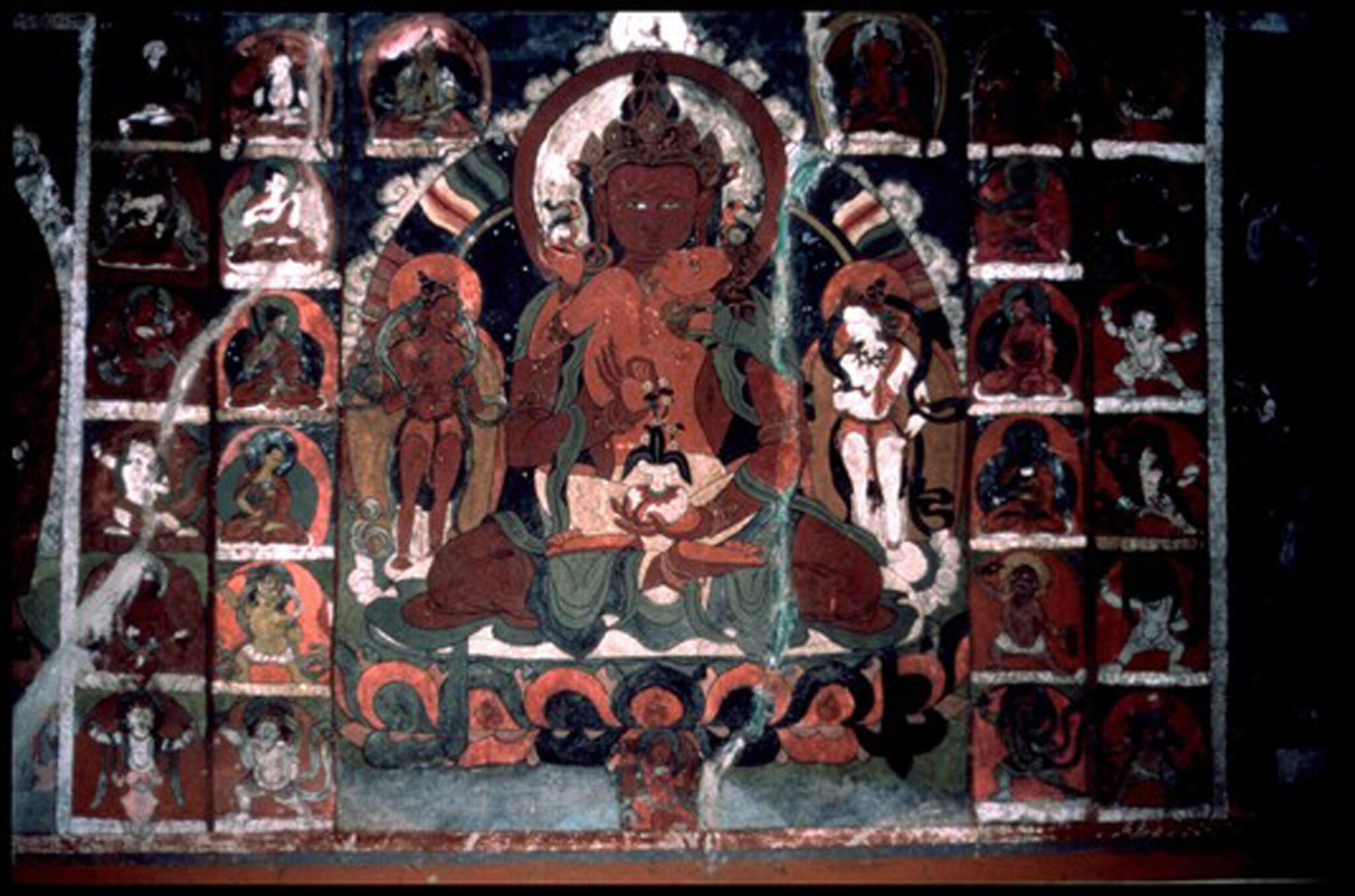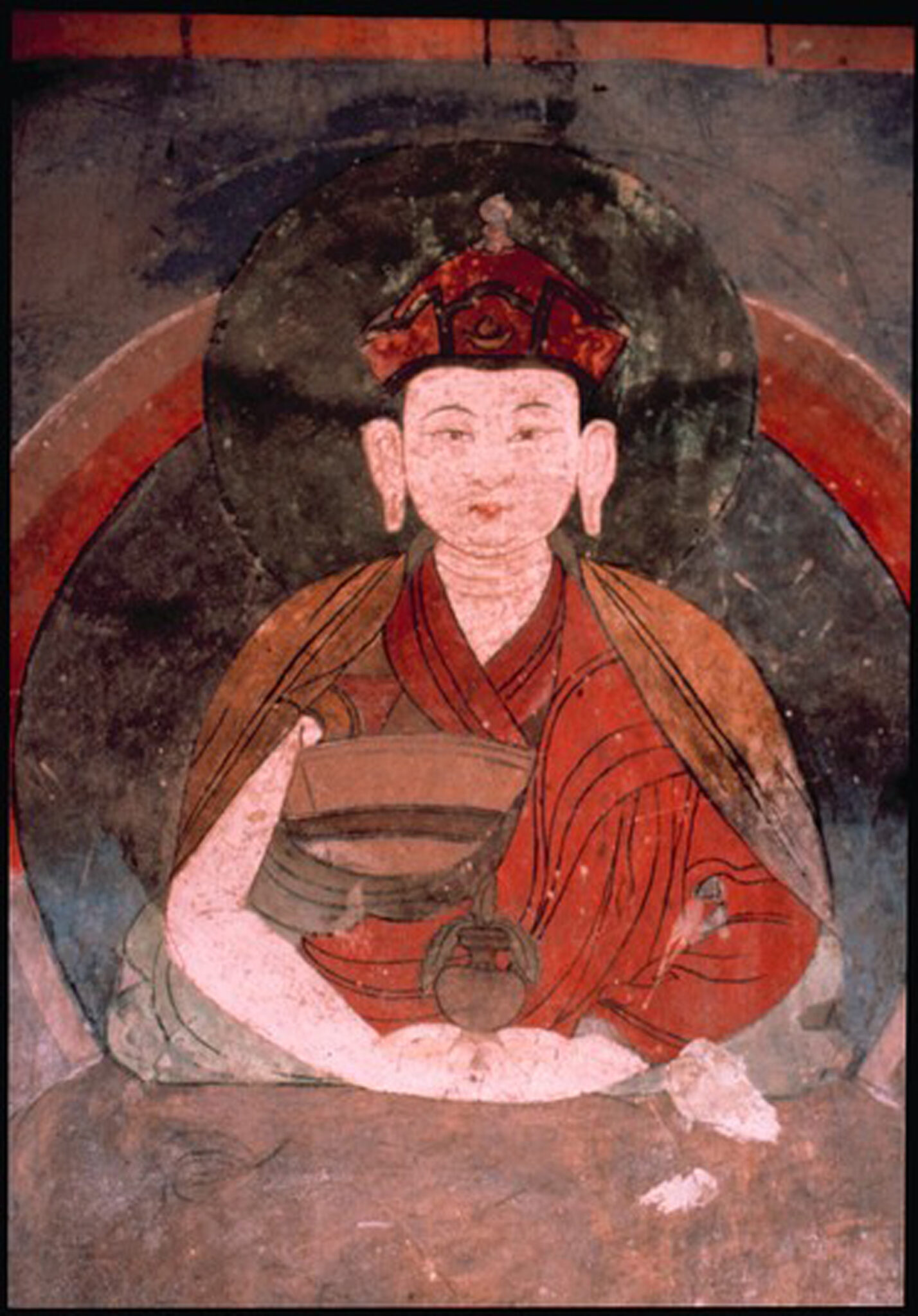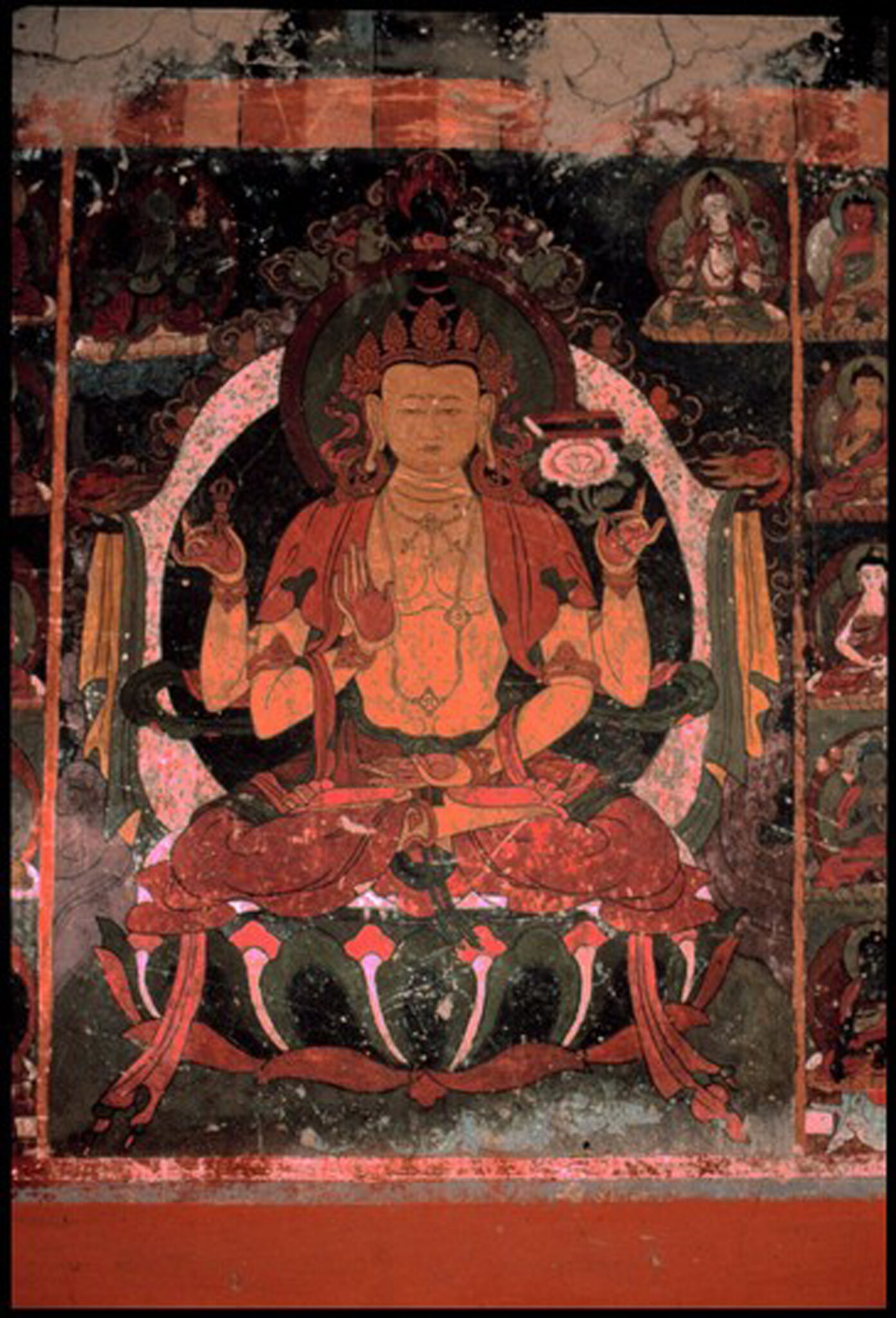Tamshing Temple
Bumthang District, Bhutan 1501–1505Tamshing Lhundrub Choling Temple; Bumthang District, Bhutan; founded 1501, consecrated 1505; photograph by Ariana Maki
A Bhutanese Buddhist Master’s Treasure House

Tamshing Lhundrub Choling Temple; Bumthang District, Bhutan; founded 1501, consecrated 1505; photograph by Ariana Maki
Tamshing Lhundrub Choling Temple; Bumthang District, Bhutan; founded 1501, consecrated 1505; photograph by Ariana Maki
Pema Lingpa was a Bhutanese master and “treasure-revealer,” a visionary who traveled the Himalayan landscape discovering concealed holy texts, sites, and objects in Bhutan and southern Tibet. In 1501, he began work on a shrine to contain these treasures and left a detailed record of the craftsmen and images. Art historian Ariana Maki explores the empowered images in this Bhutanese tantric master’s personal treasure hall, which map the qualities that must be realized in order to experience enlightenment. To this day, the influence of Pema Lingpa’s teachings is felt across Bhutan.
In the Yoga Tantras, practitioners are initiated into one of five Buddha families, which together form a mandala. Each family has a name, buddha, color, direction, and symbolic attribute:
Each of the five directional buddhas also represents a specific wisdom quality, which overcomes a corresponding mental affliction.
Dzogchen refers to ritual practices and philosophical texts associated with the Nyingma tradition of Tibetan Buddhism, as well as Bon. Dzogchen texts emphasize yogic practices, techniques for navigating the bardo states between birth and death, and the nature of the universe as pure, self-arisen consciousness.
In the Himalayan context, iconography refers to the forms found in religious images, especially the attributes of deities: body color, number of arms and legs, hand gestures, poses, implements, and retinue. Often these attributes are specified in ritual texts (sadhanas), which artists are expected to follow faithfully.
The Nyingma are a tradition of Tibetan Buddhism. The Nyingma trace their lineages back to the first introduction of Buddhism into the Himalayas in the time of the Tibetan Empire, most importantly to the legendary Indian yogin Padmasambhava. The Nyingma are known for their “treasure revealers” (Tib. terton), lamas who travel the Himalayas, revealing ritual texts, objects, and hidden lands thought to be concealed within the Tibetan landscape. The Nyingma are also famed for the Dzogchen teachings, a set of meditative practices focused on the bardo states, and the nature of the mind as pure, self-arising consciousness. Unlike other Buddhist traditions, many Nyingma practitioners are not celibate and can marry, raise families, and grant Vajrayana initiations and teachings to their children.
The Nyingma tradition of Tibetan Buddhism holds that gurus of the past like Padmasambhava concealed texts, objects, and even hidden lands (Tib. beyul) throughout the Himalayan landscape, meant for later generations to discover at the time the teachings are needed. Tantric practitioners and yogis who discover these treasures are called terton, or “treasure revealers.” Treasure revealers can also uncover “mind-treasures,” revealed to them by deities or lineage masters in dreams and visions. There are treasure-revealers in the Bon tradition as well.
Historically, Tibetan Buddhism refers to those Buddhist traditions that use Tibetan as a ritual language. It is practiced in Tibet, Mongolia, Bhutan, Ladakh, and among certain groups in Nepal, China, and Russia and has an international following. Buddhism was introduced to Tibet in two waves, first when rulers of the Tibetan Empire (seventh to ninth centuries CE), embraced the Buddhist faith as their state religion, and during the second diffusion (late tenth through thirteenth centuries), when monks and translators brought in Buddhist culture from India, Nepal, and Central Asia. As a result, the entire Buddhist canon was translated into Tibetan, and monasteries grew to become centers of intellectual, cultural, and political power. From the end of the twelfth century, Tibetans were exporting their own Buddhist traditions abroad. Tibetan Buddhism integrates Mahayana teachings with the esoteric practices of Vajrayana, and includes those developed in Tibet, such as Dzogchen, as well as indigenous Tibetan religious practices focused on local gods. Historically major traditions of Tibetan Buddhism are Nyingma, Kagyu, Sakya, and Geluk.
In 1476, at the age of twenty-six, a blacksmith was foraging for mushrooms in the forest when he paused to rest. A monk wearing tattered robes awakened him, handing him a scroll with instructions to visit a nearby cliff on an upcoming full-moon night. After some consideration, the man decided to go. He arrived at the cliff edge, which overlooked a deep riverine pool. Suddenly overcome, the man plunged into the water and reemerged holding a chest he had retrieved from a submerged cave. This marked the first of scores of such discoveries he would make throughout Bhutan and southern Tibet, and he would ultimately become known as Pema Lingpa (1450–1521), one of the Five Great Treasure Revealers of the Ancient () tradition. His appearance in the world had been prophesied by the Indian master Padmasambhava (ca. eighth century).
As Pema Lingpa continued to reveal hidden treasures (), he also accrued more patrons and greater renown, and his sphere of influence expanded far beyond his birthplace in Bumthang’s Tang Valley, reaching well into the Lhodrak region of southern Tibet, where he gave numerous teachings and conducted initiations and rituals. After nearly a quarter century of accumulating treasures and offerings, and despite having given away many tangible objects to his disciples, he shared in his autobiography that he still had significant holdings. In his words, “I realized that [having received] so many alms, I should assemble the necessary things to make a shrine.” The text describes his subsequent discussions with the local leader, wherein they came to an agreement on who would provide the labor. The local leader suggested a building site, saying, “Tamshing offers a good place for the . The ground in front of it is a good place for horse races.” Local tradition attributes another actor in the temple’s founding—the enlightened female Dorje Pakmo, who is believed to have manifested as a sow that began rooting in the ground, turning the earth to indicate where the temple cornerstone was to be placed.
The foundation was laid in the female iron bird year (1501), and the temple would become the seat of Pema Lingpa’s activities for the rest of his life (fig. 1). Tamshing serves as a storehouse for his legacy—it consolidates terma he withdrew from around the region, displays mural paintings of powerful deities unique to his tradition (fig. 2), holds sculptures consecrated with sacred substances provided by the master himself, and hosts ritual dance performances he received through visions. Local oral tradition maintains that his arm span was used as the building’s unit of standard measurement, so that the structure itself reflects his physical proportions and, by extension, his continual presence within it.

Avalokiteshvara; Tamshing Lhundrub Choling Temple, upper floor, Bumthang District, Bhutan; 1503–1505 with potential later interventions; mural; photograph by Françoise Pommaret
Pema Lingpa’s autobiography describes the artists commissioned to provide the temple’s paintings and sculptures. The sculptor Lama Chogyam is credited with shaping statues in the ground floor shrine and inserting consecratory materials such as precious and semiprecious stones, medicinal herbs, and coins, while Pema Lingpa consecrated the main image, a skyward-gazing Padmasambhava. His biography lists over a dozen objects—among them texts, small sculptures, of other Buddhist masters, and pieces of clothing from Padmasambhava and his consort Yeshe Tsogyel—that he inserted within the sculpture. Among the consecratory objects were terma that he had extracted locally as well as farther afield, for example, from Samye in central Tibet. Pema Lingpa is also credited with sculpting a self-portrait currently housed in Tamshing’s upper story. By consolidating the treasures that he withdrew from throughout the region, Pema Lingpa was demonstrating his sphere of influence while also supporting his claims to legitimacy, as the objects directly connect him with the activities he undertook at many important sites.
Pema Lingpa’s autobiography describes the temple as a “palace of images” and the murals of the courtyard as the respective realms of the deities and masters depicted, imagery that he states is being provided to adherents to support their eventual liberation from the cycle of death and rebirth. Multiple artists, including Tshepa Tshering, Kharwa Tshering, and Kuntrey, are credited with drawing and painting the murals, using pigments and materials that were gifts from Tibetans, including the Seventh , Chodrak Gyatso. Quite unusually, Pema Lingpa relates that he inserted consecratory scrolls into the plaster upon which the assembly hall murals were painted, an act rarely attested in the history of Himalayan architecture. For followers, his vivifying the wall paintings and consolidating important treasures inside sculptures exponentially increases their spiritual power and efficacy.
The consecrated murals line the walls of the courtyard, where monks and patrons assemble to receive the master’s teachings. Originally painted between 1503 and 1505, the compositions provide their intended viewers—initiates into Pema Lingpa’s tradition—with content Pema Lingpa selected, and may reflect what he considered the most salient practices from his teachings. Protective figures appear at the beginning and end of the circumambulatory path. Pilgrims enter and move clockwise past the first protective figures before turning right, where they encounter a mural of an enthroned Pema Lingpa surrounded by his previous (fig. 3).

Detail of Pema Lingpa (1450–1521); Bhutan; date unknown; mural; dimensions unknown; photograph by Françoise Pommaret
Following are successive compositions dedicated to the Seventh Karmapa Chodrak Gyatso (1454–1506), Yeshe Tsogyel (ca. eighth century), Padmasambhava (ca. eighth century), Garab Dorje (ca. sixth century), and , who together constitute an extremely condensed lineage of Great Perfection transmissions. The next subset of images begins with , a deity whose practice is a purificatory step made prior to undertaking higher-level . Following are the Five —Amoghasiddhi, , , , and —and a composition depicting the primordial buddha of the Nyingma tradition, , in union with his consort Samantabhadri. This grouping provides initiates with a condensed of the qualities that must be fully realized in order to experience enlightenment. In short, initiates may undertake the preparatory Vajrasattva practice prior to meditations associated with the Five Buddha Families, each of which provides avenues to cultivate of specific insights and overcome particular obstacles, a process intended to facilitate higher levels of awareness. Should the meditators completely master all aspects of these practices, their nature becomes indistinguishable from that of the primordial Buddhas Samantabhadra and Samantabhadri; in other words, they reach enlightenment. This wall, therefore, provides initiates with both an accounting of Pema Lingpa’s lineage and a path toward higher accomplishment.
At this point, visitors may enter the main shrine or continue along the path that passes around and behind it. The murals along the path show the sixteen , their attendants, and the Seven Universal Buddhas, some of which reveal overpainting. Visitors emerge on the opposite side of the sutra hall, where the mural compositions include practices unique to Pema Lingpa’s tradition. He described the paintings’ creation in his autobiography, referring to several compositions as “heavens”:
The lines [for the paintings] were added to the left side of the sutra hall. Senior artist Tshering began making the arrangement of the newly arisen [images]: the , the heaven of the Great Compassionate One, the Lamp that Dispels Darkness. Starting from there [successively are] the Highest and Most Secret Buddha of Long Life, [and] the Highest and Most Secret Horse-headed One. After that, peaceful Samantabhadra with consort and the forty-two deities of [the ], the landscape of the Five Blood-drinking Heruka Families, [then, further is] Highest and Most Secret Vajra-holder. Then is the heaven of the Gentle-voiced One and his retinue, the Perfection of Wisdom, and the rest of the paradises of the Buddhas of the ten directions, and the Indestructible Dagger, the Most Secret and Unsurpassed Kila, with ten ones encircling [him].
Ranging from exoteric ( and ) to esoteric (deities in union) (fig. 4), this side of the hall illustrates practices aimed at higher levels of accomplishment alongside those that provide protection, remove obstacles, and help navigate the state between death and rebirth. As a whole, the sutra hall mural program fulfills multiple functions: it ensures protection of the teachings, establishes sacred space, situates Pema Lingpa within the Nyingma tradition, and provides initiates with tools for everyday concerns and enhanced practice. Pema Lingpa’s autobiography attests that he selected the mural’s content, carefully recording their creation along with his intent that they support generations of Buddhist adherents.

Prajnaparamita; Tamshing Lhundrub Choling Temple, Bumthang District, Bhutan; 1503–1505 with potential later interventions; mural; photograph by Françoise Pommaret
Throughout his life, even as Tamshing and its images were being created, Pema Lingpa continued to be called by his patrons nearby and farther afield to give initiations, conduct rituals, oversee funerals, and resolve disputes. With numerous demands on his time, Pema Lingpa consolidated many of his treasures and teachings at Tamshing, thereby providing future generations of adherents with a continual source of blessings, and scholars with a body of texts, objects, and images that offer a window into his motivations and intent. In 1521, after decades of activities throughout the region, Pema Lingpa passed away at Tamshing. In the late seventeenth century, many of his practices were incorporated into official Bhutanese state monastic curricula, including dances and rituals that continue to be performed throughout the country and beyond, reflecting the fact that Pema Lingpa’s legacy has disseminated far beyond the walls of his home temple.
Karma Phun tshogs (Phuntsho), Gter Ston Pad+ma Gling Pa’i Rnam Thar / The Autobiography of Terton Pema Lingpa: A Brilliant and Beautiful Rosary of Gems (Thimphu: Shejun, 2015), 210. See also a translation offered in Michael Aris, “The Temple-palace of gTam-zhing as Described by Its Founder,” Arts asiatiques 43 (1988): 33.
Karma Phun tshogs (Phuntsho), Gter Ston Pad+ma Gling Pa’i Rnam Thar / The Autobiography of Terton Pema Lingpa: A Brilliant and Beautiful Rosary of Gems (Thimphu: Shejun, 2015), 210. See also Michael Aris, “The Temple-palace of gTam-zhing as Described by Its Founder,” Arts asiatiques 43 (1988): 33.
This event is regularly reenacted in a ritual dance called the Phag Cham during the temple’s annual festival, the Tamshing Phala Choepa.
Karma Phun tshogs (Phuntsho), Gter Ston Pad+ma Gling Pa’i Rnam Thar / The Autobiography of Terton Pema Lingpa: A Brilliant and Beautiful Rosary of Gems (Thimphu: Shejun, 2015), 215–16.
Michael Aris, “The Temple-palace of gTam-zhing as Described by Its Founder,” Arts asiatiques 43 (1988): 33.
Karma Phun tshogs (Phuntsho), Gter Ston Pad+ma Gling Pa’i Rnam Thar / The Autobiography of Terton Pema Lingpa: A Brilliant and Beautiful Rosary of Gems (Thimphu: Shejun, 2015), 215–16. See also Michael Aris, “The Temple-palace of gTam-zhing as Described by Its Founder,” Arts asiatiques 43 (1988): 37.
Karma Phun tshogs (Phuntsho), Gter Ston Pad+ma Gling Pa’i Rnam Thar / The Autobiography of Terton Pema Lingpa: A Brilliant and Beautiful Rosary of Gems (Thimphu: Shejun, 2015), 215.
In his autobiography, Pema Lingpa refers to the compositions as zhing bkod and zhing khams, which have an “otherworldly” sense of “buddha-field,” “heaven,” or “Buddha realm,” as well as more “this-worldly” terms like logs ris (mural).
Karma Phun tshogs (Phuntsho), Gter Ston Pad+ma Gling Pa’i Rnam Thar / The Autobiography of Terton Pema Lingpa: A Brilliant and Beautiful Rosary of Gems (Thimphu: Shejun, 2015), 216. See also Michael Aris, “The Temple-palace of gTam-zhing as Described by Its Founder,” Arts asiatiques 43 (1988): 36.
Gayley, Holly. 2007. “Patterns in the Ritual Dissemination of Padma Gling pa’s Treasures.” In Bhutan: Traditions and Changes. PIATS: 2003. Proceedings of the Tenth Seminar of the International Association for Tibetan Studies, Oxford 2003, edited by John A. Ardussi and Françoise Pommaret, 97–120. Brill’s Tibetan Studies Library 10/5. Leiden: Brill.
Harding, Sarah, trans. 2003. The Life and Revelations of Pema Lingpa. Ithaca, NY: Snow Lion.
Phuntsho, Karma. 2008. “Ogyen Pema Lingpa (1450–1521), His Life and Legacy.” In The Dragon’s Gift: The Sacred Arts of Bhutan, edited by Terese Tse Bartholomew and John Johnston, 66–77. Exhibition catalog. Honolulu and Chicago: Honolulu Academy of Arts in association with Serindia.
Ariana Maki, “Tamshing Temple: A Bhutanese Buddhist Master’s Treasure House ,” Project Himalayan Art, Rubin Museum of Art, 2023, http://rubinmuseum.org/projecthimalayanart/essays/tamshing-temple.
Lorem ipsum dolor sit amet consectetur adipisicing elit. Cum nihil placeat pariatur deserunt eius ullam incidunt maxime sunt ipsam. Ipsa, provident, laudantium, rem assumenda laboriosam veniam autem voluptas sint officia distinctio enim aut explicabo fuga animi voluptatum earum recusandae excepturi atque dignissimos iste? Exercitationem, praesentium eum. Harum ut maiores expedita exercitationem perspiciatis soluta aperiam dolores natus unde, sequi vitae debitis ex aliquam quas eum reprehenderit esse. Cumque amet et earum necessitatibus, repellendus ullam ducimus corporis architecto culpa placeat eum odit cum iure illo vitae rerum! Ullam et suscipit culpa? Eos voluptatum laudantium iste vero impedit adipisci maxime magni natus voluptatibus.
Get the latest news and stories from the Rubin, plus occasional information on how to support our work.